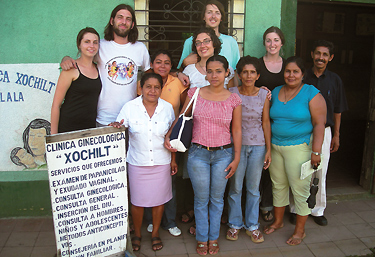Serving Women in Nicaragua
Open gallery

Kate Iris Hilburger CAS ’07 vividly remembers the first women’s health workshop she attended in rural Nicaragua. Under the scattered shade of broadleaved tropical trees, two dozen Nicaraguan women–most of them young and juggling small chidren–listened attentively to a discussion of sex and gender, learning about their bodies and cultural attitudes toward women.
“On the way back to the health clinic in El Viejo, bumping along in the back of a pickup truck, we all felt proud to be a part of this important work,” says Hilburger.
Hilburger was one of four youths from Lewis & Clark who spent their summer working at the Xochilt Cl’nica, a community-run health clinic in El Viejo, Nicaragua. She was joined by Elizabeth Fussell CAS ’07 (who had worked at the clinic twice before), Frazer Lanier BA ’07, and Megan McBride BA ’07.
The four-member team provided rural Nicaraguan women–many of whom work on banana, watermelon, or sugarcane plantations–with crucial information about sexually transmitted infections, condom use, and intimate violence. Their efforts were funded by a $10,000 grant from philanthropist Kathryn Wasserman Davis and $2,500 from Lewis & Clark. The grant from Wasserman Davis came via the 100 Projects for Peace, a nationally competitive grants program.
Among other things, the project’s funding enabled the clinic to triple the number of free gynecological exams it offers low-income women as well as to purchase an electrosurgery unit for biopsies and other uterine procedures.
“Peace is often discussed in a political context as an end to war, but there are a lot of ways that violence manifests itself in people’s lives,” says McBride. “We wanted to do something that would really be meaningful for people who are on the receiving end of a lot of structural violence and inequalities.”
More L&C Magazine Stories
Lewis & Clark Magazine is located in McAfee on the Undergraduate Campus.
MSC: 19
email magazine@lclark.edu
voice 503-768-7970
fax 503-768-7969
The L&C Magazine staff welcomes letters and emails from readers about topics covered in the magazine. Correspondence must include your name and location and may be edited.
Lewis & Clark Magazine
Lewis & Clark
615 S. Palatine Hill Road MSC 19
Portland OR 97219

